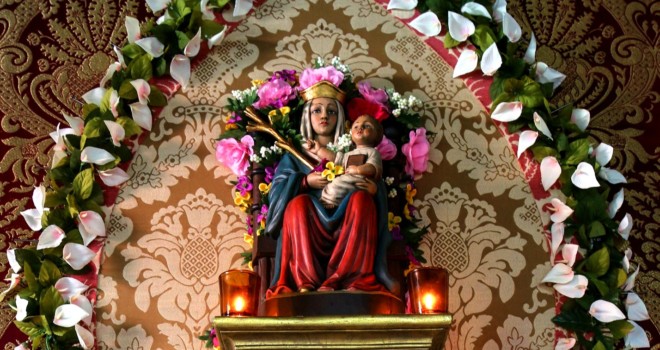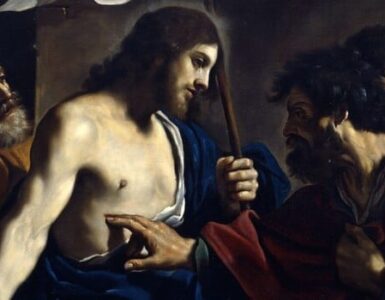In a fallen world, there is always the temptation (and the fuel) to focus on the grim and the dramatically painful, letting the small and beautiful pass by, unnoticed and uncelebrated.
So it is with the apparition and message behind the Basilica of Our Lady of Walsingham. While it seems foolish to imagine that Our Lady, the very Queen of Heaven, would deign to appear in a supernatural vision to someone, and that the heart of her otherworldly message would be swallowed up in dreary worldliness, this is precisely the fate the Walsingham apparition nearly suffered.
Today, one can visit the minor basilica, affectionately known as “The Slipper Chapel”. This chapel was once only a small part of the Walsingham pilgrimage site and was the place where the faithful would stop and remove their shoes to walk the last mile barefooted before arriving at their ultimate destination. For nearly 500 years, unnumbered, unshod pilgrims walked up to a site that first held a modest wooden house, then a small stone priory, then a much larger building with four gilded spires and a relic of St. Peter’s finger. A building that once inspired a Prior to spend so much money on its improvements that he was dismissed, and equally inspired the famous humanist Erasmus to compose a prayer in Our Lady’s honor.
A building that, thanks to the wars and greed of man, no longer stands today. Now, the relics are ashes, the stained glass smashed, and the imported stones hauled down and carted away. Today, the very building that Our Lady once requested to be constructed is gone. All that is left is the chapel where long-dead pilgrims removed their shoes to tread holy ground.
The source for the destruction is a familiar one to students of history. The English Reformation, begun by Henry VIII and followed through by his daughter, Elizabeth I, resulted in numerous martyrs for the faith, destruction of holy objects, and confiscation of Church property. The pilgrimage site of Walsingham wasn’t spared Henry’s wrath, and today, all that remains is the East Window, an unseeing eye into the sins of the past.
But if we continue even farther back into history—before the fires and destruction of the Reformation, before the large gilded priory, before the smaller first priory—we see a modest house, built upon a small dry space between two wells. And if we continue in reverse, we see a young, wealthy widow, being visited by the Blessed Virgin Mary, and being shown that first dwelling, in a small dusty space in Nazareth, where Heaven broke through to Earth because of a freely given “yes”.
The Story of Walsingham
Walsingham is, at its heart, the story of Our Lady’s fiat. In 1061, a devout widow by the name of Richeldis de Faverches desired to do something special to honor the Blessed Virgin Mary. Her wish was granted in the form of three supernatural visitations, where Mary came to the young widow and revealed the home in Nazareth where the Archangel Gabriel appeared during the Annunciation. Our Lady tasked the Englishwoman with constructing a replica in Walsingham, promising that “whoever seeks my help there will not go away empty handed”.
De Faverches took the instructions to heart, and had construction begin immediately. When human endeavors ran into architectural and engineering difficulties, angelic help rushed in, with the tradition holding that de Faverches heard singing one night and looked out her window to see the structure, now completed and in a different location than planned, with two angels leaving the construction zone.
Eventually, to protect it from the elements, the wooden structure was encased by the first stone priory. Then, as pilgrims flocked to it, a larger one, with the fire and destruction of the Reformation ultimately bringing it all down. But to focus on these aspects misses the point of Our Lady’s request. Mary requested a replica of the location of the Annunciation to be made. To drive home the importance of the Incarnation, the Mother of God asked for the physical location of her fiat to be celebrated.
What a shocking thing for people who want to keep God in strictly spiritual and intellectual realms! To imagine that a geographical space would matter to God, to think that He may feel affection for a humble dwelling place? For those who hold God at arm’s length, and feel safer when He is “On High” and not breaking through into our daily, physical world, imagining that He notices and responds to earthly buildings is a dangerous thought.
Today, little of the original Walsingham site remains. The humble wooden replica of Our Lady’s Nazarene home is long, long gone. But perhaps all is not lost. Perhaps we modern day pilgrims can pause, and reflect on where we gave our specific, individual fiats to Christ. Perhaps, if we imbued the physical locations of our conscious conversions with holiness and sanctity, the whole world would become a pilgrimage site, and no amount of fire or destruction could take it away from us.
✠












